Introduction
Victoria is considered to be a very desirable place to live, but residents and visitors also consider the safety of the city and its potential for crime in specific locations. In order to understand the location of crimes, the following questions need to be answered first: Are specific crime types randomly located, or if there is a pattern to their distribution, where would the highest levels of crime incidents be located?
According to Macleans magazine [#2] , Victoria is ranked as the 30th (out of 229) most dangerous places in Canada in 2018, with a crime severity index of 119 (Canadian average is 70.96). In 2018, according to data from the Victoria Police Department, there were 13,712 crimes, which were categorized into 18 different types of crime (explore the interactive map in figure 1 at the top of this page to view all of the 2018 theft crime locations) [#3].
The Victoria Police Department provides police service to both the City of Victoria and the Township of Esquimalt, and though crime rate statistics have been falling, police costs have been rising, and the Victoria Police Department are regularly requesting a larger budget [#4]. Police are kept busy investigating a variety of crimes, needing to secure and assess each incident (see figure 2).

Figure 2. Bright orange Police tape acts to secure a potential crime scene. [Image Source: Victoria News, 2019-07-23 #5]
Crime pattern theories describe crime events as complex, and that the motivation and opportunities for criminal offenders are not random, nor are their locations distributed evenly. The use of space by people is based on available urban pathways and boundaries, as well as routine patterns of activity of both criminals and victims, thus many crimes can be expected to occur in areas that become a part of common activity routines of both the criminal and the victim [#6]. To analyze crimes, a proposed hypothesis would be that the location of crime events is random, unless statistically proven otherwise to have a patterned distribution. Four different point pattern distribution analysis tests will be performed on the 18 different crime types to determine if this hypothesis holds true for any of the crime types in Victoria. Understanding the distribution of crime event locations, and identifying the locations with the highest incidents of crime may help researchers identify patterns and locations which might ultimately help the police reduce the levels of crime in the city.
Study Site: City of Victoria
Victoria, the provincial capital city, has a warm mediterranean-like climate, and is located on British Columbia's southwest Pacific coast in the Salish Sea at the southern tip of Vancouver Island, on unceded Coast Salish land. The city of Victoria has southern and western boundaries bordering on the waters of the Inner Harbour and Juan de Fuca Strait, and covers over 21.36 km² of land area [#7], with over 97 km of major roads, 161 km of other paved roads, and 475 km of concrete sidewalks [#8].
Many Canadians move to Victoria to retire and many tourists come to visit, though with the city becoming an increasingly more expensive place to live, there is also an increasingly larger population of homeless and other very poor people who have a difficult time surviving on low incomes. In the most recent 2016 census, the population of the City of Victoria was 85,792, having grown 5,774 from the previous census in 2011, with a population density of 4015.7 people/km², 25% of whom are over 65 years of age, 70% are of working age (15-65), of which 55% are employed and 3% are unemployed. Incomes range from under $10,000 to over $150,000, with a median annual income of $34,164, and with 10% of the population making less than $10,000, and 15% making between $10,000 and $19,999, thus at least 25% of the population are not making enough income to afford to live in such an expensive city. Victoria is also the largest municipality in the Capital Regional District, with 22.38% of the Greater Victoria Area 2016 population of 383,360 [#9].
The newly published Vital Signs 2019 survey report [#10] gives Victoria a C+ for standard of living, regarding the availability of services, food and opportunities for work, and a B grade for safety and the presence of police. During 2018, the Victoria City Police, who also serve the Township of Esquimalt, have filed incidence reports for 13,712 crimes in the City of Victoria [#3]. The Downtown Victoria Business Association have requested more police visibility citing the increase in crimes, along with concerns about safety, to be associated with the increase in the street population of disadvantaged people who tend to congregate close to the centralized services offered to them in the city core [#11]. Thus, some policing costs for theft-related crimes may actually be more the social issues of poverty and wealth disparity.
Data
Crime statistics, for both Victoria and Esquimalt from January 2011 to September 2019, were downloaded from the Victoria Police Department, in a csv file organized by the incident id and case number, including the incident date and time, type of incident grouped within 18 different crime categories, as well as the address and location coordinates, resulting in a file containing 137,530 different crime data location points [#3].
The City of Victoria's perimeter boundary was needed to trace the exact extent of the city boundaries, in order to determine which of the crimes were located in Victoria. The boundary coordinates are available in the form of a polygon area shapefile, projected in UTM zone10, in the coordinate system NAD83 GRS80. The City Boundary for Victoria, BC files were downloaded from the City's open public data portal [#7].
The City of Victoria is also comprised of 14 different neighbourhoods, and the perimeter boundary coordinates for each neighbourhood are available in the form of a multi-polygon area shapefile, projected in UTM zone10, in the coordinate system NAD83 GRS80. The Neighbourhood Boundaries files were downloaded from the City's open public data portal [#12], and the boundaries of the neighbourhoods were used as a base map to form the final point density distribution estimation maps.
Analysis
Before analysis, the data first needed to be downloaded and prepared for use. As this study is only interested in analyzing the 2018 City of Victoria Police crime statistics, the crime points data needed to be subset to include only those crimes that occurred during the year 2018, and include only the information we needed to analyze the data set: the date, location coordinates and the grouping of 18 different crime types. Also, as the Victoria Police serves both Victoria and Esquimalt, the City of Victoria boundary shapefile was used to create an intersection with the crime data points, bounding an extent that will include only the crimes in Victoria. Before finding the density of crime points per unit area, the duplicated point coordinates were removed, then Victoria's area needed to be calculated, which was be done in two ways, both ending up with different values. Calculating the spatial geometry of the shapefile polygon follows the coastal outline with a bit more exactness, resulting in the larger area of 21,363,930 m², than simply relying on the shapefile-defined area of 21,347,203,m². Figure 3 shows a drop-down selection of interactive maps for each of the 18 different crime types, and each of the crime event point locations, without reference to spatial distribution. The Open Street Map at top of this webpage (see figure 1) is an interactive leaflet map showing all of the 2018 City of Victoria Theft Crime data points (to reset the map to the original extent after exploring the data, simply reload this webpage).
Figure 3: Select different interactive maps of all 18 crime types in 2018, using the drop-down list.
Explore the data points by clicking the circle markers for crime type and date.
Before doing any spatial analysis, it is difficult to determine if there is any concentration of crime point locations.
Testing for Random Distribution
To determine if the crimes in Victoria were randomly located or had some significant spatial pattern, each separate crime incident was grouped into 18 different incident types, upon which a series of four different point pattern analysis tests were done on the data: the Nearest Neighbour Distance (NND), the Quadrat Grid Cell (Quad), the K function (K-Func), and the Kernel Density Estimation (KDE).
NND: The Nearest Neighbour Distance test measures are based on the distances between points, and can explain the spatial distribution at different distance ranges. To be considered clustered there would be more than the expected average of random neighbouring points (the distance between points is less than a random average), and to be dispersed there would be fewer neighbouring points than a random distribution (the distance between points would be greater than a random average). The NND test was run to calculate the average distance between each neighbouring crime type point and comparing this distance to that of a randomly located neighbour, based on the density of the number of each particular crime type points in ratio to the total study area (21,363,930 m²). If the average distance was equal to the random distance, the crime locations would be random, however, if the resulting z score value confidence level was 95% or higher (two standard deviations around the normal distribution), those crimes would not be considered random, but instead have a patterned distribution. If the mean NND distance was greater than the NNDr random distance, the pattern would be a dispersed pattern, and if less, the pattern would be clustered (see Table 1).
Quad: Like the NND, the Quadrat density test uses area to calculate the point density, however to do this, the Quad divides the study area into a grid of quadrat cells, and the density of points is calculated for each quadrat, based on the number of points found within each quad. The number of quadrats affects the p value test results by changing the density of points per unit area; smaller cell sizes provide more detail with a finer resolution, but may suggest more variability than is true on a more realistic scale. The p value output represents the probability of falsely accepting the hypothesis of randomness, and with a p value of lower than 0.05, the point distribution would not be considered to be random. If the quadrats are too small (too many quads), there will be many cells with no points, and if they are too large (too few quads), any change in point density over a small area may be difficult to determine. If the Variance (VAR) is greater than the mean, the distribution is dispersed, and if the variance is less than the mean, the distribution is clustered.
K-Func: The K function looks at the point distribution patterns of clustering or dispersion at a variety of distance scale ranges between points, to see if patterns of neighbourhood size change over different scales and distances [#13]. As the distance between points increases, so too will the number of neighbouring points. If the number of neighbouring points is higher than a random number of points, the distribution will be clustered, and if the number is smaller, the distribution will be dispersed. On a graph of the points, if the points fall within the confidence band interval, then the likelihood of the point distribution being different than random increases.
KDE: The Kernel Density Estimation is a smoothing function that provides a measure of the estimated accuracy of the crime event point density at the city block level. Different values of sigma band width, ranging from 25m radius around a crime point (kernel) to 300m, were tested to determine which of the bands would provide the best estimate of crime point density with a minimum error (see figure 4). If the bandwidth is too small, there is too much variability over a small space, and if too large, variability will be less visible over a larger scale. A cross-validation method was then used to compare the predictive model to the actual crime point pattern distribution, to determine the best band width to use, with the minimum mean square error. These interpolated values are displayed as a continuous 2-D surface of similar values, and the hotspots of colour can be used to identify where the areas of highest density of crime event points will be. The Victoria neighbourhood boundary shapefile was used as a base map for the KDE to help identify any patterns in neighbourhood crime locations (#12).
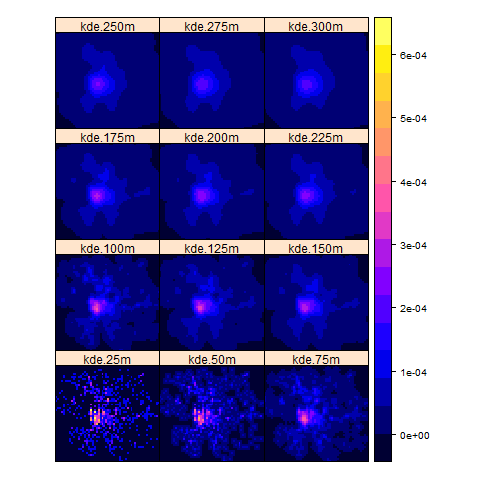
Figure 4. KDE sigma bands options from 25m - 300m for the crime of Theft. The areas of highest density are in the pink and yellow colours.
Are Crimes Randomly Located?
If points are considered to be randomly distributed, as the null hypothesis of this study states, there would be nothing unusual about the distribution of points beyond an ordinary randomness. However if the point distribution is not considered to be random, there would be a statistically significant distribution to the points, suggesting some pattern of either clustering or dispersion, would could then eventually lead to further investigation of the underlying causes.
The two test results that provide the initial analysis for randomness are the NND, which provides the z-score (Z), and the Quad, which provides the p-score (PVAL). If the NND test z-score was greater than +/- 1.96, which is the 95% confidence level, and if the Quad test p value was less than 0.05, which is the probability of this level of confidence being wrong, the crime type locations would be considered to be a non-random pattern. If the mean NND distance was greater than the NNDr random distance, the pattern would be a dispersed, and if less, the pattern would be clustered; if the Quad test variance (VAR) is greater than the mean, the distribution is dispersed, and if the variance is less than the mean, the distribution is clustered (see Table 1).
Table 1. Z and P value Statistics, in the two grey columns, were used to determine, with 95% confidence, whether a crime event was randomly located, and if not whether the distribution was clustered or dispersed. The horizontal grey rows are four crime types that will be further analyzed.
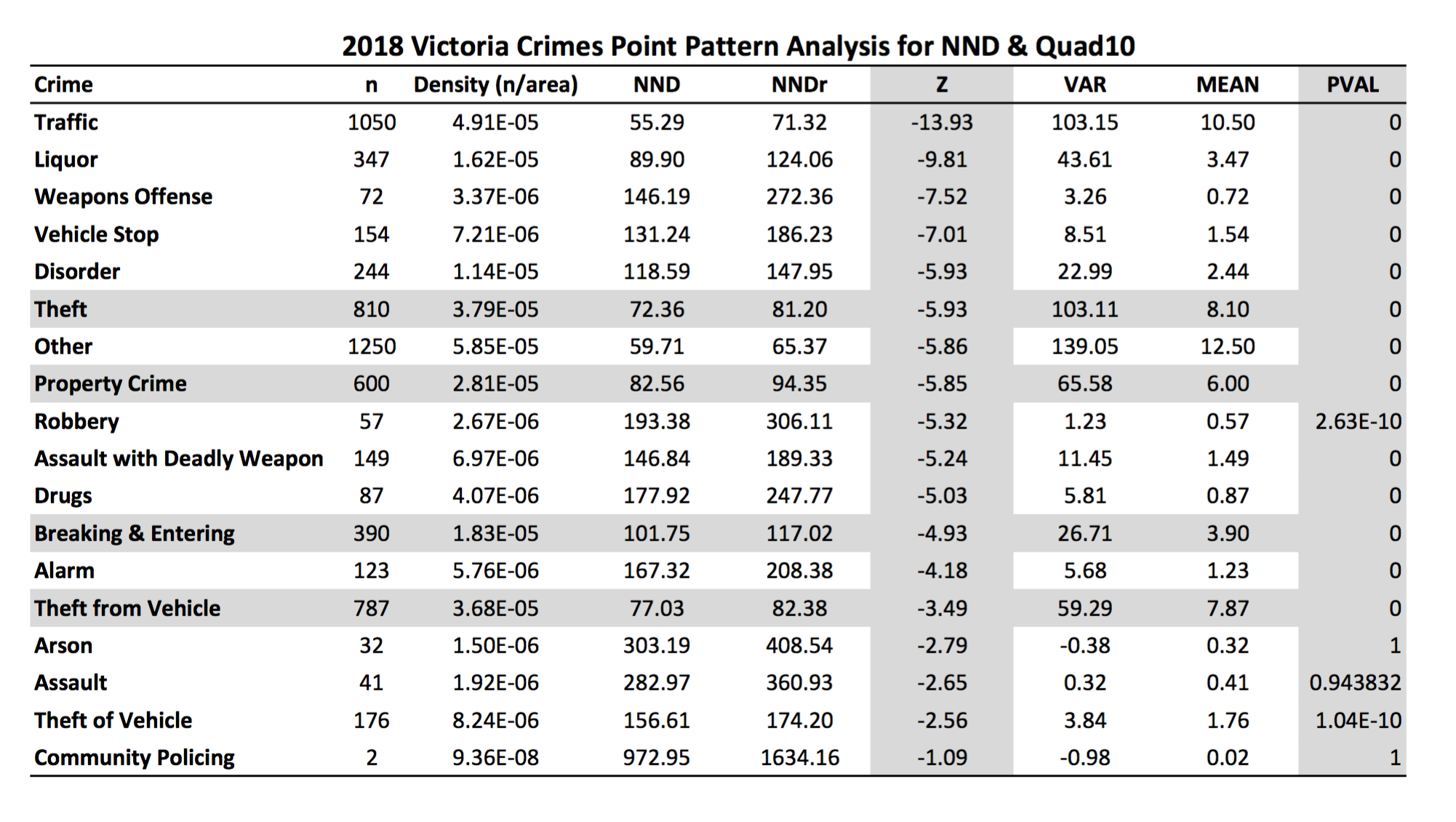
The only crime type which met the criteria for being randomly located was Community Policing, which had the smallest z-score 1.09 of all the crimes, which is less than the 1.96 value that would give us confidence of non-randomness; the p-value of greater than 0.05 confirms this. Though Arson, Assault, and Theft of Vehicle also all had z-values of over 1.96, suggesting with 95% confidence that they had non-random crime location distributions, the p-values are almost 1, stating a 100% probability that the decision to deem these crime locations to be non-random could be wrong!
Where Are The Highest Incidences of Crimes?
If the hypotheses that crime locations are random is found not to be true, with a 95% confidence level, crime locations will be considered non-random, with a significant distribution pattern which could be either dispersed (points equally spread over area) or clustered (points located closer together than random).
Statistically speaking, the crimes that were considered to have a non-random, distributed pattern, in order of the most significance, were: Traffic, Liquor, Weapons Offense, Vehicle Stop, Disorder, Theft, Other, Property Crime, Robbery, Assault with Deadly Weapon, Drugs, Breaking & Entering, Alarm, and Theft from Vehicle. The following detailed analysis of the four different point pattern distribution tests were done for each of the Theft, Property Crime, Breaking & Entering, and Theft from Vehicle crimes. Will these crimes of thievery offer any insights into crime distribution in the City of Victoria?
I. Crime Type: Theft
The non-random point pattern distribution of Theft Crimes is Clustered, with the most incidents located around the Downtown Neighbourhood, and spilling over to the east into the Harris Green Neighbourhood, which is confirmed by the following four test results:
NND: The number of Theft crime event data points were 810 with a density of 4.91E-05 points / m². The point pattern is considered non-random as the z value was -5.93 which is well above the -1.96 value of 95% confidence that the distribution will be patterned, and as the NND value of 72.36 is less than the NNDr value of 81.2, the distribution would be considered clustered (see Table 1).
Quad: The number of quadrats was set at 10, creating 100 quad grid cells covering the area of Victoria. The p value is so very small that the output states a 0% chance that the 95% confidence of being non-random would be correct (see Table 1, and Figure 5).
K-Func: The K function graph shows that a line connecting the number of neighbouring points is higher than a random number of points, and that the distribution will be clustered (see Figure 6).
KDE: The Kernel Density Estimation tests using different block-level sigma band radius the crime point kernel (see figure 4), to find the best sigma value with the minimum mean square error using cross-validation, 150m, and then plots a 2-D interpolated surface of the highest density distribution of crime points (see Figure 7 and 8). The Victoria Neighbourhood Boundaries perimeters are used as a base map to help identify locations of higher density.
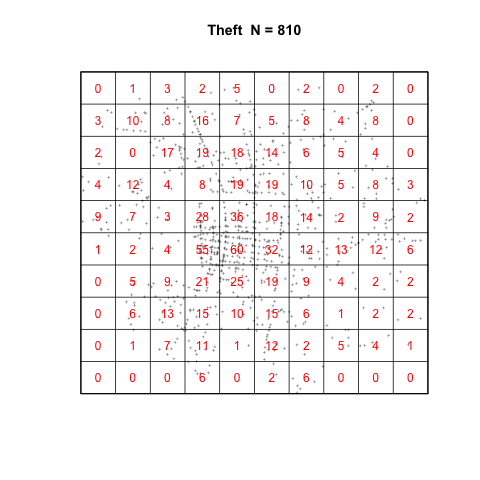
Figure 5. Quad grid of Theft.
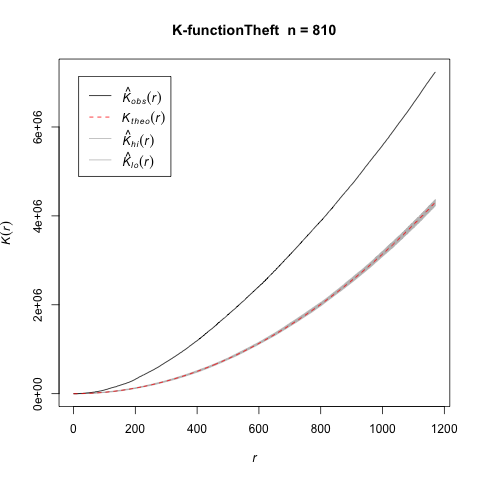
Figure 6. K function significance graph of Theft.
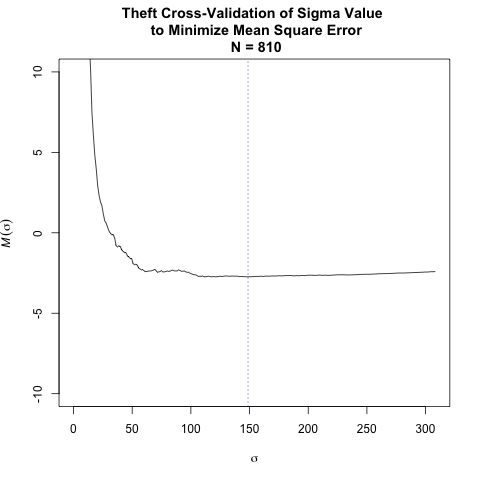
Figure 7. KDE Cross Validation of the Distance Band (metres) to minimize mean square error of Theft.
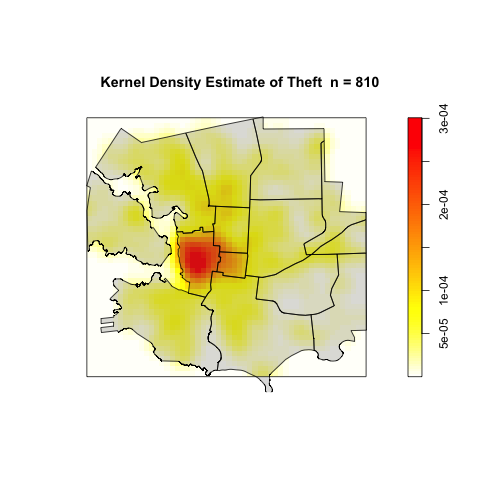
Figure 8. Best Kernel Density Estimate of Theft.
II. Crime Type: Property Crime
The non-random point pattern distribution of Property Crimes is Clustered, with the most incidents located around the Downtown Neighbourhood, and spilling over to the east into the Harris Green and north into the North Park Neighbourhoods, as well to a lesser extent north along Douglas St., which is confirmed by the following four test results:
NND: The number of Theft crime event data points were 600 with a density of 2.81E-05 points / m². The point pattern is considered non-random as the z value was -5.85 which is well above the -1.96 value of 95% confidence that the distribution will be patterned, and as the NND value of 82.56 is less than the NNDr value of 94.35, the distribution would be considered clustered (see Table 1).
Quad: The number of quadrats was set at 10, creating 100 quad grid cells covering the area of Victoria. The p value is so very small that the output is a 0% chance that the 95% confidence of being non-random would be correct (see Table 1, and Figure 9).
K-Func: The K function graph shows that a line connecting the number of neighbouring points is higher than a random number of points, and that the distribution will be clustered (see Figure 10).
KDE: The Kernel Density Estimation tests using different block-level sigma band radius around the crime point kernel (see figure 4), to find the best sigma value with the minimum mean square error using cross-validation, 150m, and then plots a 2-D interpolated surface of the highest density distribution of crime points (see Figure 7 and 8). The Victoria Neighbourhood Boundaries perimeters are used as a base map to help identify locations of higher density.
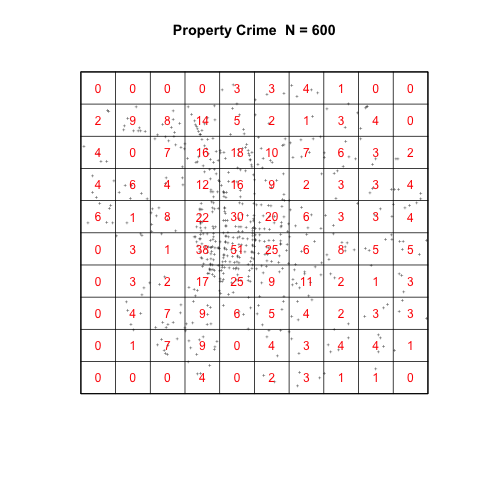
Figure 9. Quad grid of Property Crime.
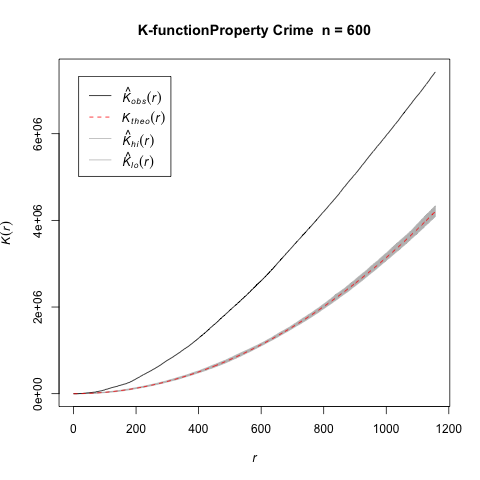
Figure 10. K function significance graph of Property Crime.

Figure 11. KDE Cross Validation of the Distance Band (metres) to minimize mean square error of Property Crime.
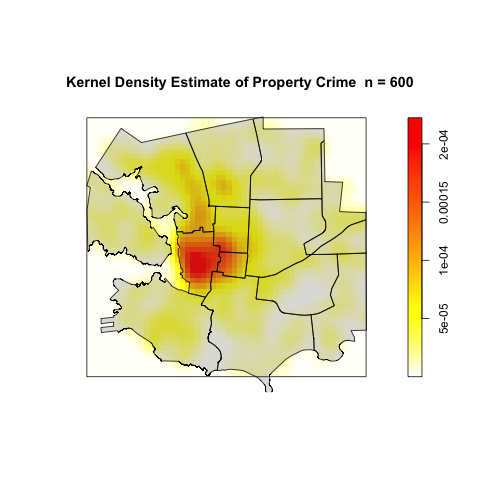
Figure 12. Best Kernel Density Estimate of Property Crime.
III. Crime Type: Breaking & Entering
The non-random point pattern distribution of Breaking & Entering Crimes is Clustered, with the most incidents located around the Downtown Neighbourhood, and spilling over to the east into the Harris Green and north into the North Park Neighbourhoods, north along Douglas St. and into the Burnside residential neighbourhood,which is confirmed by the following four test results:
NND: The number of Theft crime event data points were 390 with a density of 1.83E-05 points / m². The point pattern is considered non-random as the z value was -4.93 which is well above the -1.96 value of 95% confidence that the distribution will be patterned, and as the NND value of 101.75 is less than the NNDr value of 117.02, the distribution would be considered clustered (see Table 1).
Quad: The number of quadrats was set at 10, creating 100 quad grid cells covering the area of Victoria. The p value is so very small that the output is a 0% chance that the 95% confidence of being non-random would be correct (see Table 1, and Figure 13).
K-Func: The K function graph shows that a line connecting the number of neighbouring points is higher than a random number of points, and that the distribution will be clustered (see Figure 14).
KDE: The Kernel Density Estimation tests using different block-level sigma band radius around the crime point kernel (see figure 4), to find the best sigma value with the minimum mean square error using cross-validation, 150m, and then plots a 2-D interpolated surface of the highest density distribution of crime points (see Figure 7 and 8). The Victoria Neighbourhood Boundaries perimeters are used as a base map to help identify locations of higher density.
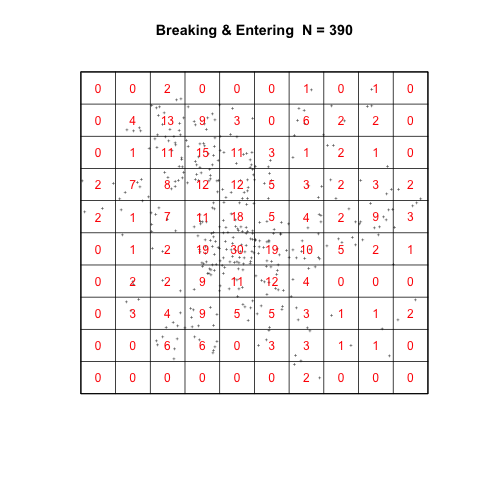
Figure 13. Quad grid of Breaking & Entering.
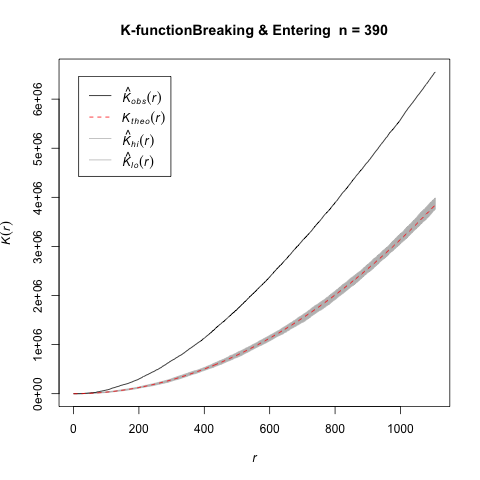
Figure 14. K function significance graph of Breaking & Entering.
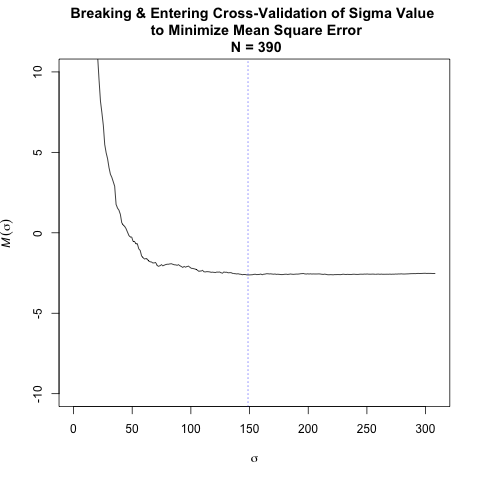
Figure 15. KDE Cross Validation of the Distance Band (metres) to minimize mean square error of Breaking & Entering.
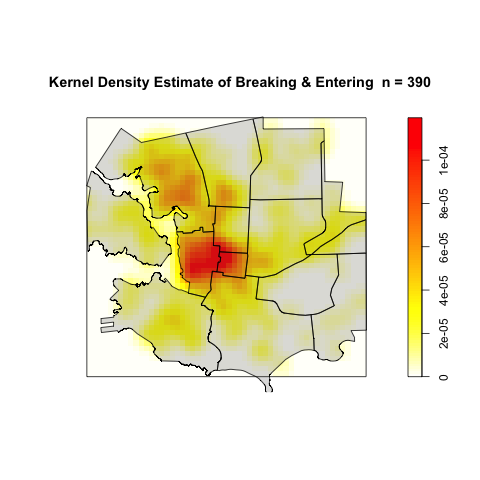
Figure 16. Best Kernel Density Estimate of K_Breaking & Entering.png.
IV. Crime Type: Theft from Vehicle
The non-random point pattern distribution of Theft from Vehicle Crimes is Clustered, with the most dispersed areas of highly clustered areas in the downtown core, and along major roadways, and both residential and business, areas with the most incidents located around the Downtown Neighbourhood and east along Fort St., which is confirmed by the following four test results:
NND: The number of Theft crime event data points were 787 with a density of 3.68E-05 points / m². The point pattern is considered non-random as the z value was -3.49 which is well above the -1.96 value of 95% confidence that the distribution will be patterned, and as the NND value of 77.03 is less than the NNDr value of 82.38, the distribution would be considered clustered (see Table 1).
Quad: The number of quadrats was set at 10, creating 100 quad grid cells covering the area of Victoria. The p value is so very small that the output is a 0% chance that the 95% confidence of being non-random would be correct (see Table 1, and Figure 17).
K-Func: The K function graph shows that a line connecting the number of neighbouring points is higher than a random number of points, and that the distribution will be clustered (see Figure 18).
KDE: The Kernel Density Estimation tests using different block-level sigma band radius around the crime point kernel (see figure 4), to find the best sigma value with the minimum mean square error using cross-validation, 150m, and then plots a 2-D interpolated surface of the highest density distribution of crime points (see Figure 7 and 8). The Victoria Neighbourhood Boundaries perimeters are used as a base map to help identify locations of higher density.
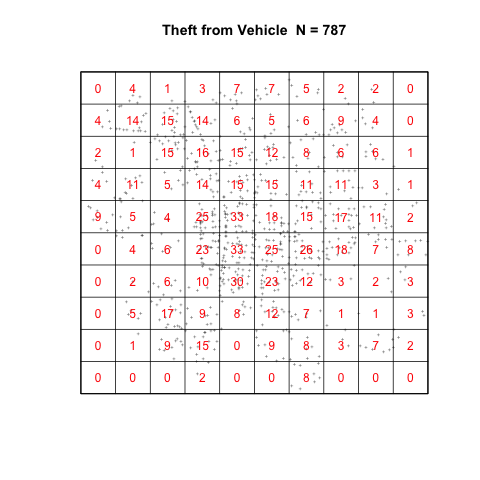
Figure 17. Quad grid of Theft from Vehicle.
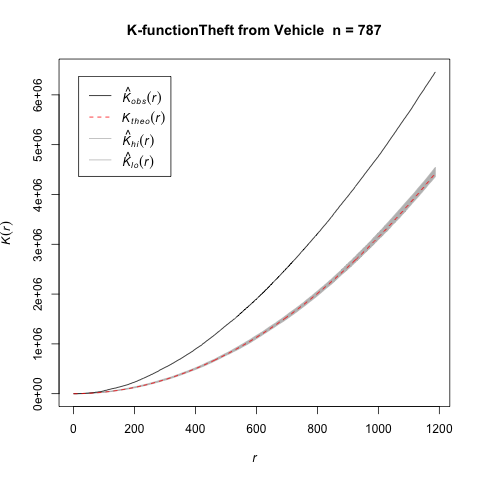
Figure 18.K function significance graph of Theft from Vehicle.
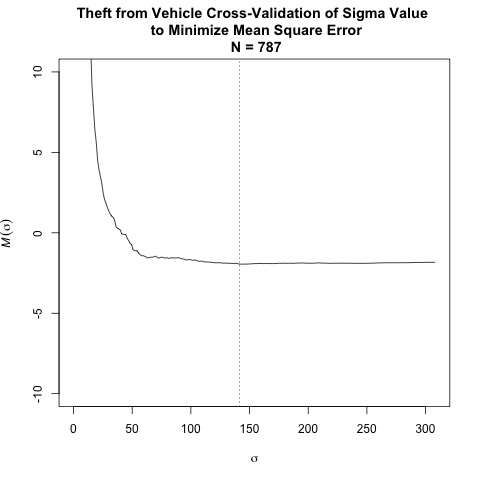
Figure 19. KDE Cross Validation of the Distance Band (metres) to minimize mean square error of Theft from Vehicle.
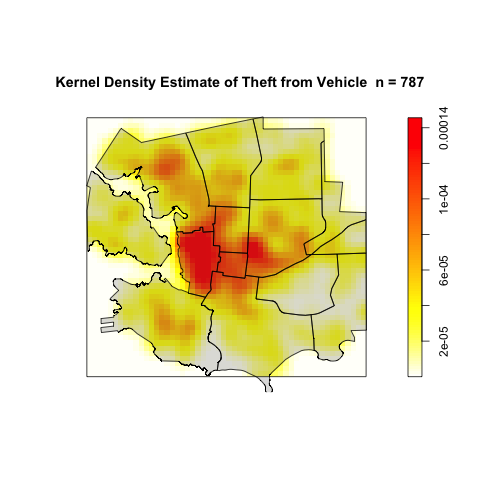
Figure 20.Best Kernel Density Estimate of Theft from Vehicle.
Limitations
The Victoria Police Department crime data may not include all the crimes that occur in Victoria, and though the locations are generalized to the blocks in levels of one hundred to maintain privacy, some incident addresses are actually located where the incident was reported and not necessarily where the crime occurred [#14]. Also, as part of the data preparation to do the point pattern distribution analysis, all of the points with duplicate coordinates were removed, so the actual density of the number of crimes committed at those locations will be underestimated.
The Other crime type has too many different crimes aggregated together to make any patterns meaningful, and some of the crime types have too few crime events to be able to make reliable statements about their distribution. This study also does not test to see if any of these different crimes are related, nor is any information available about the person who committed these crimes, or to even know if Victoria crimes are committed by Victoria residents.
One limitation that affected the Nearest Neighbour Distance (NND) test was in the choice of one out of two the City of Victoria area calculations. Choosing the area that used a more refined method resulted in a larger area, creating a lower density of crime location points per unit area, which may have underestimated the significance of spatial patterning. Also there could be a biased edge effect in NND, as there would be fewer neighbours at the points nearest the edge, because some neighbours would be outside of the study area boundaries.
The number of 10 quadrats chosen for the Quad test could have impacted the results if the quad cells were too small, which would indicate a more clustered distribution with a higher point density than if a larger number of quad cells were used. Likewise, the results of different sized KDE band widths (see figure 4) can suggest a more clustered distribution if the band width chosen was too large.
The Takeaway?
Crimes in Victoria are not random, but have distribution patterns that can be identified and analyzed
As a result of performing the four different point pattern analysis tests on the 18 different crime types, the only crime type that was found to be randomly distributed was Community Policing. However, due to the conflicting levels of confidence and probability of making an error, care would need to be taken with any statements made about the distribution patterns of the Arson, Assault, and Theft of Vehicle crime types. The other 14 crime types, with a level of 95% confidence, were found to be statistically non-random with a patterned spatial distribution (see Table 1). The testing of the four non-random theft and property-related crime types highlighted in this study, Theft, Property Crime, Breaking & Entering and Theft from Vehicle, each confirmed that these crime event locations were found to be most highly clustered in the Downtown Neighbourhood of Victoria, spreading out into surrounding residential neighbourhoods along the main roads.
These findings confirm the theory of crime location patterns [#6] that most crimes are not randomly located, but do indeed have some pattern to the distribution of the crime event locations, and may be related to the regular activities of both the criminals and their victims. Though police presence is necessary to both deter and investigate crime in areas with a high density of crime events, other social issues maybe at play, and criminalizing people with the disadvantage of limited resources in poverty and income disparity, may not be the best use of resources to help reduce crime. In order to increase a sense of personal safety in city locations known to have a higher density of crime events, citizens could help by being more aware of their surroundings, and securing their personal possessions out of sight, which may help prevent some crimes of opportunity and temptation.
References
(To return to the referenced text, click the linked reference number)
#1. Open Street Map. (2019). Open Street Map [basemap for interactive leaflet map]. Retrieved 2019-09-21 from https://www.openstreetmap.org/#map=17/48.56151/-123.46913
#2. Macleans. (2019). Canada’s Most Dangerous Places 2018. [webpage]. St. Joseph Communications. Retrieved 2019-10-08 from https://www.macleans.ca/canadas-most-dangerous-places/
#3. Victoria Police Department. (2019). Victoria (BC) Police Department incident dataset. [csv file: 2019-09-21]. Retrieved 2019-09-23 from https://moto.data.socrata.com/dataset/Victoria-BC-Police-Department/f42u-v6f3
#4. CBC News. (2019-02-17). Victoria police will cut staff unless council increases budget, chief says. [webpage]. Retrieved 2019-10-08 from https://www.cbc.ca/news/canada/british-columbia/victoria-police-budget-1.5022300
#5. Depner, Wolf. (2019-07-23). Greater Victoria sees crime severity index rise. Victoria News. [news article: photograph]. Retrieved 2019-09-30 from https://www.vicnews.com/news/greater-victoria-sees-crime-severity-index-rise/
#6. Brantingham, Patricia L. (2010). Crime Pattern Theory. In Fisher, Bonnie S. and Steven P. Lab (Eds.). Encyclopedia of Victimology and Crime Prevention. Sage Knowledge. (pg 193-198). Retrieved 2019-10-09 from https://sk.sagepub.com/reference/victimologyandcrime/n67.xml
#7. City of Victoria. (2019). City Boundary for Victoria, BC. [shapefile: 2019-09-21]. Retrieved 2019-09-23 from http://opendata.victoria.ca/datasets/city-boundary/data
#8. City of Victoria. (2019). Streets. [webpage]. Retrieved 2019-09-23 from https://www.victoria.ca/EN/main/residents/road-maintenance/streets.html
#9. Statistics Canada. (2017). Victoria, City, British Columbia and Capital, Regional district, British Columbia, Census Profile, 2016 Census. [table]. Retrieved 2019-09-30 from https://www12.statcan.gc.ca/census-recensement/2016/
#10. Victoria Foundation. (2019). Vital Signs 2019. [pdf]. Retrieved 2019-10-08 from https://victoriafoundation.bc.ca/wp-content/uploads/2019/09/Vital-Signs_2019_lowres.pdf
#11. Douglas Magazine. (2019-03-07). Downtown Victoria Sees Rising Crime and Looks to VicPD for Answers. [webpage]. Retrieved 2019-10-10 from https://douglasmagazine.com/downtown-victoria-sees-rising-crime-and-looks-to-vicpd-for-answers/
#12. City of Victoria. (2019). Neighbourhood Boundaries. [shapefile: 2019-09-21]. Retrieved 2019-09-23 from http://opendata.victoria.ca/datasets/neighbourhood-boundaries
#13. ESRI. (n.d.). How Multi-Distance Spatial Cluster Analysis (Ripley's K-function) works. [webpage]. Retrieved 2019-10-10 from https://pro.arcgis.com/en/pro-app/tool-reference/spatial-statistics/h-how-multi-distance-spatial-cluster-analysis-ripl.htm
#14. Victoria Police Department. (2019). Crime Reports. [webpage]. Retrieved 2019-09-23 from https://www.vicpd.ca/crime-reports